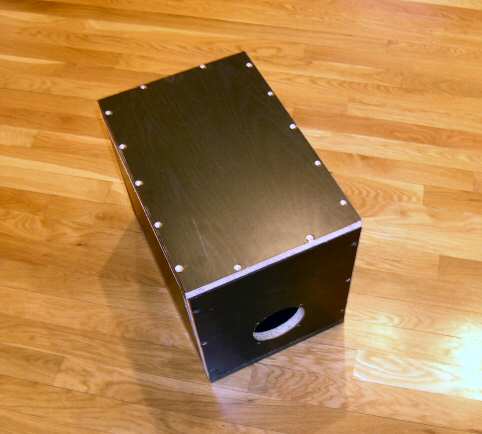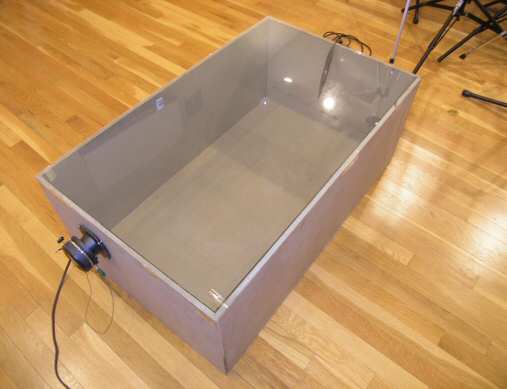 |
This is the first prototype "live room" with dimensions of 14.8 by 11.7 by 9.3 inches. |
| www.ethanwiner.com - since 1997 |
Ethan's Failed Reverb Live
Room Project
February 2, 2010
Some time ago I came up with a seemingly fabulous idea for a clever product I was sure could make a million dollars. I thought about it for a year, then finally decided it was too good an idea not to pursue. The only problem was that in the end it didn't work! One of the people who helped me with this failed project suggested I describe the idea in writing anyway, in case others want to try it. So following is my "million dollar" idea, and the reason it didn't work.
Reverb is a common recording effect, and years ago good reverb units were very expensive. When I owned a pro studio in the late 1970s and early 1980s, we had an EMT plate reverb that cost about $7,000. Adjusted for inflation that would be nearly $19,000 today! EMT plate reverbs are still revered, but even more revered are "live rooms" where a loudspeaker and microphones are placed in a highly reflective room to obtain genuine natural reverb. The live reverb rooms at Capitol Records and other well-known recording studios are famous for their high quality and stunning realism. Today in 2010 there are excellent digital reverbs that do a great job simulating a live room. But the best models are still expensive, and they don't have the panache of a live chamber.
Building a live reverb chamber is a huge, expensive proposition. It must be very quiet and isolated from outside sounds, which requires expensive construction. The room must also be large enough to have a long decay time that's uniform over a wide range of frequencies, doesn't ring and resonate, or favor some frequencies over others. If only there was a way to get high quality reverb out of a "room" the size of a suitcase, while avoiding the mode and resonance problems inherent in all small spaces.
Many recording engineers are familiar with pitch-shifting effects that transpose a voice or guitar part up or down to a new key, or fix vocals that are out of tune. So my idea was to use digital signal processing to shift the music up in frequency by a fixed 10 KHz offset, play that through a tweeter into the tiny "room," record the result with a stereo pair of microphones, then shift the music back down to its original frequencies.
The pitch-shifting effects recording engineers use are not suitable for this application because they add artifacts when shifting more than a few half steps. But there's another type of pitch shift called heterodyning that is perfectly linear. However, this type of pitch shift is not musical because all frequencies are shifted by a constant number of Hz. Musical pitch shifters shift by some number of half steps and cents, preserving the relation of the note fundamentals and their harmonics. When an A-440 note is shifted musically up an octave, the fundamental and harmonic frequencies are all doubled, not merely offset by the fixed 440 Hz fundamental frequency. But for this application using a fixed frequency offset is fine, because the original frequency shift would be reversed by the same amount after being captured by microphones.
So far so good. In fact, the more I thought about this, the better it seemed. Since music from 20 Hz through maybe 10 or 15 KHz would be shifted up to start at 10 KHz or even higher, not much sound isolation would be needed even if the "room" were placed near loud thumping loudspeakers. Lower frequencies that leaked into the box could simply be filtered out of the microphones. Better, one of the goals with reverb is to have the same decay times over eight or more octaves, and my reverb would compress 20 Hz through 10 KHz into a single octave. Further, if 20 Hz is shifted up to 10,020 Hz, a very small box could be acoustically equal to a room 100 feet long. Woo hoo!
So I asked my friend master craftsman Phil Cramer to build me a small box out of finished MDF shelving I bought at Home Depot. The box shown below was as small as I deemed reasonable, and followed a "known good" ratio with dimensions of about 15 by 12 by 9 inches. I bought a tweeter rated up to 25 KHz and mounted it in a hole at one end, then put my DPA 4090 measuring microphone inside with the cord passing though a small slot Phil cut under the top lid.
 |
This is the first prototype "live room" with dimensions of 14.8 by 11.7 by 9.3 inches. |
I was fortunate to hook up with Christian-W. Budde, an awesome VST plug-in developer in Germany. Christian was kind enough to modify his Bode Frequency Shifter plug-in to do exactly what I needed, letting me shift audio up and back down by 11 KHz so I could test my reverb "room" with real music. It wouldn't work in real time of course. If this became a product I'd use DSP circuitry that works in real time. So for now I'd shift the music up by 11 KHz in the SONAR audio program I use, play that through a power amp and tweeter, record the shifted music in stereo with my Zoom H2 portable recorder, then shift the Wave file back down in SONAR to hear it.
Son of a gun, it sounded almost like real reverb!
But the decay time was too short, sounding more like a "stage" preset rather than a hall. And when I measured the reverb decay time at high frequencies, it was barely 1/4 second over most of the range between 2 KHz and 22 KHz. I figured at least two seconds was needed for this to be a viable product. So I asked Phil Cramer to make me a second box, much larger, shown below. I even made a spreadsheet to figure out the largest size that could be affordably shipped via UPS or FedEx.
 |
This second prototype was much larger at 37.5 by 22.5 by 15 inches. |
I fully expected this box, the size of a luggage trunk with eight times more volume than the first box, to have eight times longer reverb. Alas, it was not to be. The decay times of this box were about 15 percent longer than the first one. So in a last ditch effort to make this work, I had a local glass shop cut pieces of window glass to line the entire box. I taped the glass in place inside, with a glass cover for the top, as you can see above. That extended the reverb time at 5 KHz and above somewhat, but it was still nowhere near long enough. D'oh!
I don't consider the project a total failure, because I always wanted to know how much more reflective glass is compared to wood and MDF at very high frequencies. So I added the data from this failed project to my article Does Wood Really Sound Warm? on the RealTraps web site.
In hindsight I realize that the fundamental problem is the absorption of high frequencies by air. For the second, larger box, I calculated that the sound would have to bounce back and forth 660 times before decaying by 60 dB to yield an RT60 time of two seconds. Perhaps a working version of this idea could still be built if the chamber were sealed air tight, and filled with a gas having less absorption than air. But that's a much more complicated product than I'm willing to design and manufacture!
Ethan Winer has been an audio professional for most of his adult life. He now heads up RealTraps, where he designs acoustic treatment products for recording studios and home listening rooms.
Entire contents of this web site Copyright © 1997- by Ethan Winer. All rights reserved.